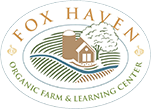Foragers 2 Week 1: Learning to See What’s in My Own Backyard by Emma Williams
At first, it seemed odd to walk into the forest to prune wild shrubs, one of my fellow foragers said at our first meetup on Saturday. Through the lens of both capitalism and conservation, it’s common to think of land as either wild or cultivated, someplace we leave alone or someplace we strive to control.
Yet the previous week we had watched Tending the Wild, a documentary about Native Californians’ approach to sustaining and being sustained by the land, which spoke to an in-between approach. They try to intervene in a way that will benefit both plants and people.
“This is very stewardly,” said another forager as we pruned the spicebush, then she wondered aloud if stewardly was actually a word.
On Saturday, we took a short walk along the Catoctin waterway to a wooded area outside of the main Fox Haven grounds. We learned to identify spicebush in winter, often on the edge of the overstory’s end, its branches reaching into a “v” with spherical buds. Spicebush’s identity can be confirmed with the scratch and sniff test, the bark smelling like a cousin to cinnamon and cloves. We learned the principles of pruning – snipping to remove anything broken, foreign tangling vines, and places where the plant’s branches are looping back onto themselves, creating friction and risk for self-injury.
My husband joked that Fox Haven had gotten me to pay them to do their yardwork for them. But it was more than that – good discussion and lots of sharing of knowledge. For example, I feel confident about identifying turkey tail mushrooms now. And I know that the powdered spicebush could be used in place of cinnamon.

 Did you know black walnut trees can be tapped for syrup, just like maple trees? Here Lacey Walker and a foragers group member carrying buckets to the walnut trees.
Did you know black walnut trees can be tapped for syrup, just like maple trees? Here Lacey Walker and a foragers group member carrying buckets to the walnut trees.
Pictured: Tapping the black walnut trees.
Before that, spicebush made me feel guilty; I had received a cute little tin of dried, ground spicebush berries from the herbal CSA around three years ago, then left it to languish unused in my spice cabinet.
When George W. Bush was president, he was occasionally mocked by the press for spending a lot of time clearing brush on his Texas ranch. On Saturday I was reminded of the appeal of this activity. It’s so tangible and satisfying, and it puts mild aggression to good use. Or to use a more contemporary cultural reference, during the early days of the pandemic, many of us started doing jigsaw puzzles. Sorting the pieces and putting them together created a sense of control and order that was missing in other aspects of our lives. So, too, when the climate and environmental problems seem so large, it is satisfying to just help a few spicebushes thrive.
I came home with a bundle of spicebush twigs, determined not to put them to waste. Things I have used them for so far:

-Simply boiling the twigs in water and letting them steep for 10 minutes produces a warming, subtle tea.
-Using that water for a base for making tea the way I learned in India (equal parts water and milk, boiled with black tea and spices.)
-Adding to tea made with cacao bark.
I think it would also be good with chaga or dandelion root but haven’t tried it yet.
As I feared, the powdered spicebush in my cabinet no longer smelled fresh. I tried making ink from it, but it was just the pale brown you can see in the lettering at the top of this page.
While I was pruning the spicebush, I suspected that there were more in the woods behind my house, that I saw them every day but didn’t know their names. In fact, there are about a dozen. Now I recognize them and have pruned them to gather more twigs. In the fall, I may gather more berries and not waste them this time, or I may just be stewardly and leave them for the birds to enjoy.

Written by Emma Williams
